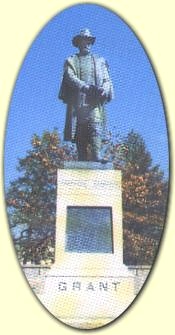Leavenworth County, KS
 The land where Leavenworth and Fort Leavenworth are located today was originally inhabited by the Kansa, Osage and Delaware Indians and today many of our streets are named after these and other local Indian tribes.
The land where Leavenworth and Fort Leavenworth are located today was originally inhabited by the Kansa, Osage and Delaware Indians and today many of our streets are named after these and other local Indian tribes. Somewhere in the vicinity of present day Salt Creek Valley northeast of Leavenworth, the French operated a fur trading post for possibly a score of years in the mid-1700's. This was the earliest white settlement of the region.
In 1827, Colonel Henry Leavenworth founded Fort Leavenworth on the bluffs of the Missouri River. For the next several decades Fort Leavenworth played an important role in keeping the peace among the various Indian tribes and the increasing number of settlers heading west. By the 1840's, travel to Oregon and California had begun and thousands of wagons passed through Fort Leavenworth on the way to the Santa Fe and Oregon Trail.
In 1854, the City of Leavenworth was founded as the very first city of Kansas.
In 1858, the Sisters of Charity of Leavenworth settled here. In 1864, the Sisters opened St. John's Hospital and in 1923 founded St. Mary College.
In 1863, the legislature passed an act to erect the Kansas St. Penitentiary on a site which is now located within the city of Lansing. The contract to build the prison was let in 1863 and work started in 1864. However, because of money difficulties connected with the Civil War, work stopped in 1864 and did not resume again until 1866. The building was first occupied in 1868.
In 1878, Lansing was platted into town lots.
In 1881, the school that was later to become the U.S. Army Command and General Staff College was founded on Fort Leavenworth by General William T. Sherman. Some of the many famous students and instructors at the college are George C. Marshall, Dwight D. Eisenhower, Douglas MacArthur, Colin Polwell and George Patton.
In 1885, the Wadsworth of Old Soldiers Home was built, and later became the Veterans Administration Center. In 1893, the Immanuel Chapel, made famous in Ripley's "Believe It or Not", was built on the V.A. grounds.
In 1906, the first cellhouse of the Leavenworth Federal Penitentiary was opened. Among the infamous criminals incarcerated here were Al Capone, Machine Gun Kelly and Robert Staud, the Birdman of Alcatraz.
There are a great deal of wonderful sites and experiences waiting for you and we hope that you will get the opportunity to enjoy some of our renowned Kansas hospitality.
Explore Leavenworth County
River Connection Tour
The River Connection Tour is a great way for you and yours to spend a couple of days or a family weekend. A multitude of interesting historical attractions, sites and experiences are available daily and spending more than a day is a definite must to capture the true flavor of our communities.
Leavenworth, KS ToursTonganoxie Community Historical Society Museum
The Tonganoxie Community Historical Society (TCHS) owns and operates 10 acres, called the Site, with four buildings. They are The Honey Valley School house, Reno Methodist Church, Fairchild/
Tonganoxie, KS MuseumsHeadquarters Area
Headquarters area buildings are named for Generals Sherman, Grant, and Sheridan. They were built from 1859 to 1904 and are on the site of the former soldiers burying ground.
Fort Leavenworth, KS Historic BuildingsOld Stone Wall
The Stone wall behind and across the street from Grant's statue is a favorite with photographers. The wall was restored in the early part of this century by the Daughters of the American Revolution.
Fort Leavenworth, KS LandmarksNational Fred Harvey Museum
The National Fred Harvey Museum seeks to: * Restore the Harvey residence in Leavenworth to its historic magnificence. * Increase public awareness of Mr. Harvey's achievements and his contributions to civilizing the great American Southwest. *
Leavenworth, KS MuseumsLeavenworth Historical Wayside Tour
Leavenworth, the "First City of Kansas", invites you to take a walk back in time and explore the history of "Where the West Began" by visiting our Historic Wayside Tour.
Leavenworth, KS ToursCommand & General Staff College
The School of Application for Cavalry and Infantry, established in 1881.
Fort Leavenworth, KS CollegesUnited States Penitentiary -
Leavenworth is best known for the "Federal Pen" or "Big House", which is now a medium-security prison. Construction of this historic prison began in 1897, with the first cell house opening in 1906. The Federal Penitentiary has been the home of Kansas City Boss Tom Pendergast, George "Machine Gun"
Leavenworth, KS PenitentiariesFrontier Army Museum
The Frontier Army Museum depicts the Frontier Army (1817-1917) and history of Fort Leavenworth (1827-present). The original collection began in 1939 when the wagon shop at Fort Leavenworth closed and the horse-drawn vehicles were relocated and called the "Old Rolling Wheels Museum". In 1960
Fort Leavenworth, KS MuseumsTonganoxie Water Park
The Tonganoxie Water Park is a modern facility with two large water slides, spray ground, zero depth entry main pool, toddler pool, a full bathhouse, and a large water area for recreational and fitness activities. The Water Park is open from Memorial Day weekend to Labor Day annually.
Tonganoxie, KS Water ParksFrench Cannons
These beautiful artifacts of bygone wars remain a mystery at Fort Leavenworth. They were cast in the 1700s in Paris; the name of the foundryman and place and date of manufacture are on each piece. How or why they came to Leavenworth is unknown.
Fort Leavenworth, KS Military HistoryC.W. Parker Carousel
Ride a restored antique wooden 1913 Parker carousel and tour the museum dedicated to telling the remarkable story of C. Parker, the "Carnival King". There are two other carousels in the museum. One is the oldest operating, hand-cranked, wooden carousel, built around 1860 and the other is a 1950
Leavenworth, KS One Of A Kinds